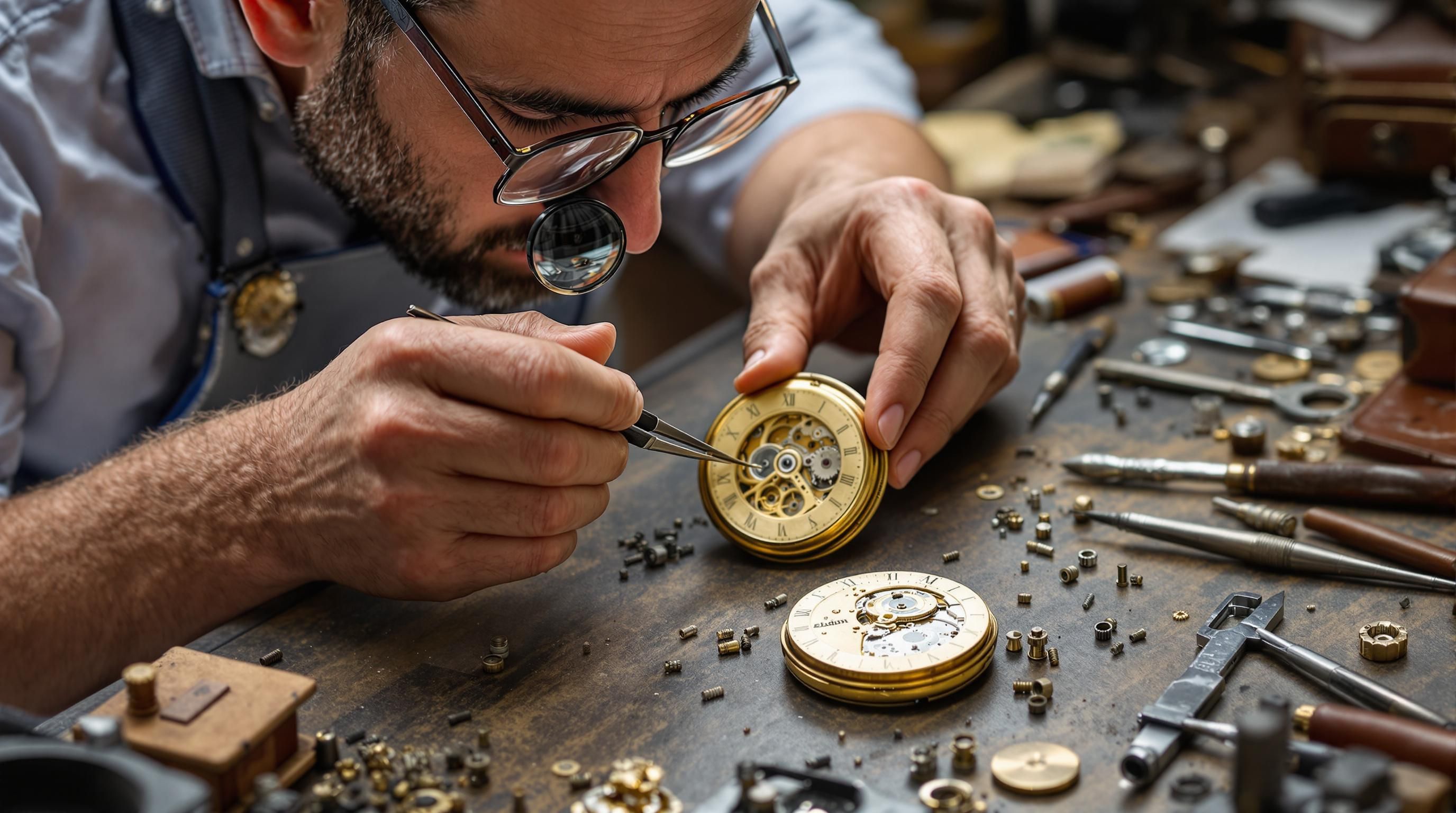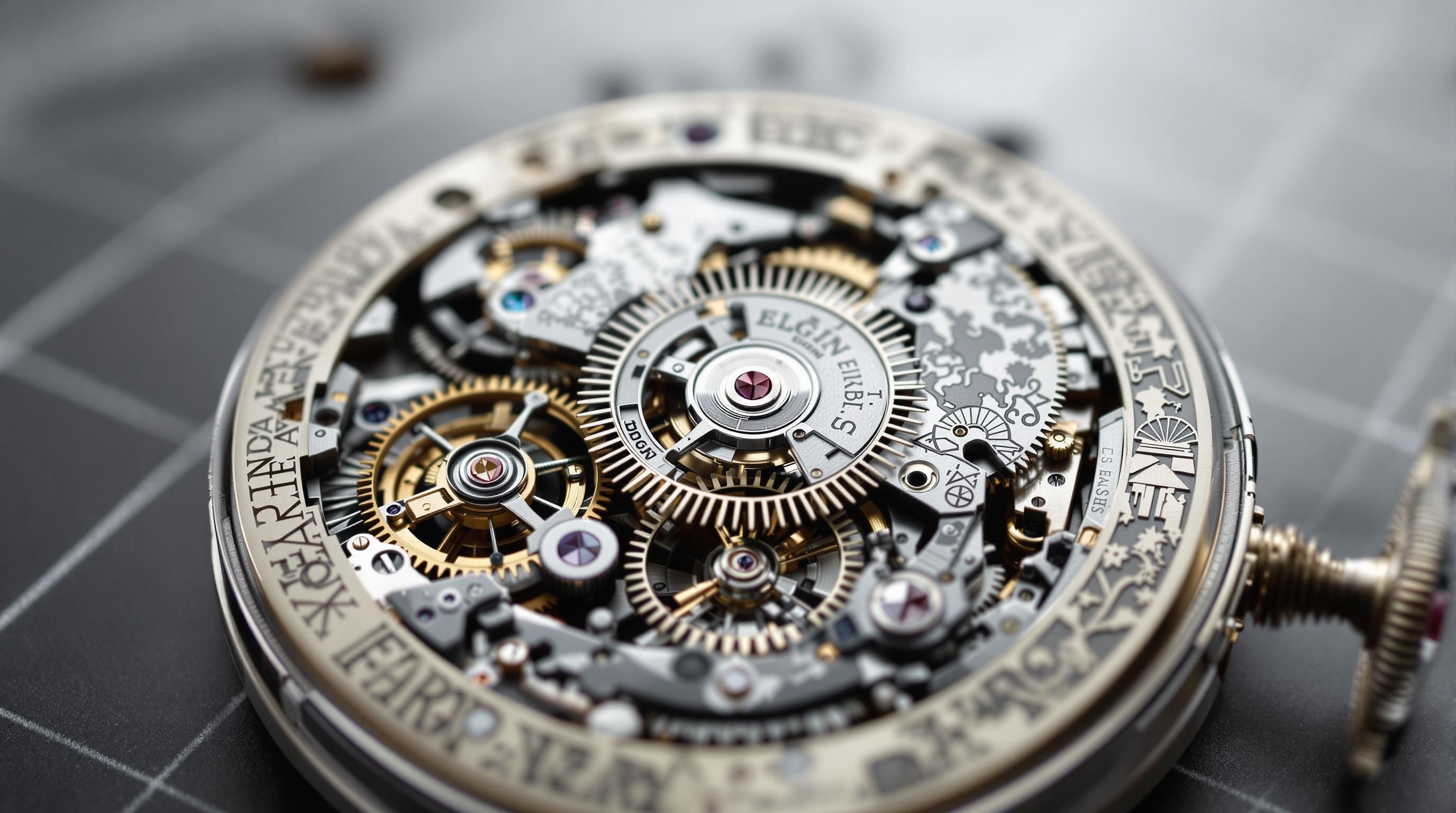Introduction to Elgin Pocket Watches
Whether you’ve inherited an Elgin pocket watch from a family member or are considering adding one to your collection, understanding its value is essential. This comprehensive guide will help you identify, evaluate, and determine the worth of your vintage Elgin timepiece in today’s market.
Elgin Pocket Watch Market Overview
The History of Elgin National Watch Company
Elgin Watch Company Historical Timeline
- 1864
Founding
The National Watch Company was founded in Elgin, Illinois. The company was established to create quality timepieces with interchangeable parts using modern manufacturing methods. - 1874
Name Change
The company officially changed its name to the Elgin National Watch Company, reflecting its hometown and establishing a brand identity that would last for decades. - 1910s
Peak Production
Elgin reached its production peak, manufacturing thousands of watches daily. During this era, the company produced many of the pocket watches that are highly collectible today. - 1930s-40s
Military Production
During World War II, Elgin produced specialized watches for military use, including navigation watches and chronometers. These military models are particularly valuable to collectors today. - 1964
Factory Closure
After a century of operation, the original Elgin factory in Illinois closed, marking the end of the company's classic American-made pocket watch production.
By the time of its closure, Elgin had produced approximately 60 million watches, making it one of the most prolific watch manufacturers in American history. This production volume means that many Elgin pocket watches have survived to the present day, creating a robust collectors’ market with pieces available at various price points.
Identifying Your Elgin Pocket Watch
The most important identifier for any Elgin pocket watch is its serial number. Elgin meticulously recorded production details, and today these records allow for precise dating and identification.
Finding the Serial Number
To locate the serial number on your Elgin pocket watch:
- Open the case back (typically the rear cover that protects the movement)
- Look for a number engraved on the movement (not on the case)
- The serial number is usually 5-8 digits long
- Record this number carefully, as it’s the key to identifying your watch
Once you have the serial number, you can use online resources like the Pocket Watch Database to determine:
- Exact production date
- Watch grade (quality level)
- Number of jewels
- Movement specifications
- Original production details
Understanding Watch Grades
Elgin, like other American watch companies, produced watches in various “grades” that indicated quality levels. Higher-grade watches featured:
- More jewels (synthetic rubies used as bearings)
- Better regulation and adjustment
- Higher-quality finishing
- More complex mechanisms
Common Elgin grades include:
- Railroad Grades: Meeting strict railroad accuracy standards
- High-Grade Models: Father Time, Veritas, Lord Elgin
- Mid-Grade Models: G.M. Wheeler, B.W. Raymond
- Standard Grades: Various numbered grades
Higher-grade watches are generally more valuable to collectors, with railroad-grade models being particularly desirable.
Key Value Factors for Elgin Pocket Watches
Movement Quality and Grade
The internal mechanism (movement) is often the most important value factor for a collectible watch. Desirable movement features include:
- Higher jewel count (17+ jewels)
- Railroad grade certification
- Special adjustments (temperature, position)
- Unusual complications or features
- Pristine condition with all original parts
Movement Condition Assessment
Check applicable items to help determine your watch's condition value
- Watch runs accurately when wound
- All hands are original and intact
- Movement is clean with no rust or corrosion
- All jewels are present and undamaged
- Balance wheel oscillates freely
- Original factory finishing is intact
- No amateur repair marks or damage
- Movement matches case (not a marriage)
Case Material and Condition
Watch cases significantly impact value, with precious metal cases commanding the highest prices:
- Solid Gold: 14K or 18K cases (marked as such)
- Gold-Filled: Gold layer bonded to base metal (marked “GF” with guarantee)
- Coin Silver: 90% silver (often in earlier models)
- Sterling Silver: 92.5% silver (hallmarked)
- Base Metal: Lowest value, often gold-plated or nickel
Case designs also matter, with hunter cases (with covers), multicolor gold, and engraved or artistic cases bringing premium prices.
Dial Condition and Style
The watch face (dial) can significantly affect value:
- Original Condition: Minimal hairline cracks or staining
- Special Dials: Fancy Roman numerals, unusual layouts
- Montgomery Dials: Railroad-style with all hour numerals
- Fancy or Rare Dials: Double-sunk, specialized markings
- Hand Style: Original blued steel or gold hands preferred
Restored or refinished dials typically reduce collector value by 30-50%.
Rarity and Historical Significance
Some Elgin watches are inherently more valuable due to:
- Limited production runs
- Association with historical events
- Military use (especially WWII models)
- Unusual features or experimental designs
- First or last examples of a particular model
Elgin Pocket Watch Value Ranges
Current market values based on recent auction results and dealer listings
</tbody>
</table>

Most Valuable Elgin Pocket Watch Models
Railroad Grade Watches
Railroad-grade Elgin watches are among the most sought-after models. After a series of railroad accidents attributed to inaccurate timepieces, railroads established strict standards for employee watches. These requirements included:
- Minimum 17 jewels (often 21 or 23)
- Adjusted to 5 positions
- Temperature compensation
- Large size (typically 16-18 size movements)
- Bold, legible dials (often Montgomery style)
Notable railroad-approved Elgin models include:
- B.W. Raymond
- Father Time
- Veritas
Rare and Limited Production Models
Some Elgin models had limited production runs or featured unusual characteristics that make them especially valuable today:
- Lord Elgin Pocket Watches: The highest-quality line, often in solid gold cases
- Early Key-Wind Models: Made before stem-winding became standard
- Convertible Watches: Designed to be worn as both pocket and wrist watches
- Multicolor Gold Cases: Featuring artistic designs in different gold colors
- Special Order Models: Custom-made for wealthy clients or organizations
Military Issue Watches
Elgin produced watches for military use, particularly during World War II. These models feature:
- Robust construction
- High visibility dials
- Dust and moisture resistance
- Military markings on case backs
Authentic military-issue watches with documented provenance can sell for $1,000-$2,500 or more.
Notable Elgin Pocket Watch Auction Results
Recent high-value sales from major auction houses and online platforms
| Category | Price | Notes |
|---|---|---|
| Railroad Grade (21+ jewel) | $700-$3,000+ | Higher for excellent condition or rare models |
| Solid Gold Case Models | $1,200-$12,000+ | Value heavily dependent on gold content and case design |
| Silver Case Models | $300-$800 | Coin silver often commands higher prices than sterling |
| Gold-Filled Case Models | $200-$600 | Hunter cases typically worth more than open-face |
| Military Issue Watches | $500-$2,500+ | WWII models with documentation bring premium prices |
| Ladies' Pendant Watches | $200-$1,500 | Gold cases and elaborate designs increase value |
</tbody>
</table>
Condition's Impact on Elgin Watch Value
Condition Grading Scale
Collectors and dealers typically use these condition categories:
Mint/New Old Stock (NOS): Virtually unworn, possibly still in original packaging. May increase value by 100%+ over standard examples.
Excellent: Minimal wear, fully functional, all original parts, case retains sharp details. Often commands 50-75% premium.
Very Good: Light wear consistent with age, minor case smoothing, fully functional. Generally sells at market average.
Good: Noticeable wear, possibly with minor repairs, functioning but may need service. Often sells at 25-40% below market average.
Fair/Poor: Significant wear, damage, or non-original parts. May sell at 50-70% below average as “restoration projects.”

The Impact of Repairs and Modifications
Many antique watches have been serviced, repaired, or modified over their lifetime. These changes can significantly impact value:
Original vs. Replacement Parts: Non-original hands, crystals, or movement parts typically reduce value by 15-30%.
Case Refinishing: Polishing that removes original detailing or hallmarks can decrease value by 20-40%.
Dial Restoration: Refinished dials generally reduce collector value by 30-50%, even if they look better cosmetically.
Movement Service: Recent professional service by a qualified watchmaker can enhance value by ensuring functionality without damaging originality.
“Marriages”: Watches with non-matching cases and movements (assembled from different original watches) typically sell for 40-60% less than proper matched examples.
Where to Buy and Sell Elgin Pocket Watches
Online Marketplaces
eBay The largest online marketplace for vintage watches offers:
- Wide selection at various price points
- Auction and fixed-price formats
- Buyer protection policies
- Global audience of collectors
However, buyers should exercise caution, as listings may have inaccurate descriptions or insufficient photos. For sellers, eBay charges fees but provides access to the largest potential customer base.
Specialized Watch Sites Platforms focused specifically on watches include:
- Chrono24 (premium watches)
- WatchCount (eBay watch search tool)
- Watch-specific forums with sales sections
These sites often attract more knowledgeable buyers willing to pay premium prices for quality pieces.
Auction Houses
Traditional and online auction houses handle higher-value Elgin watches:
- Heritage Auctions
- Christie’s
- Sotheby’s
- Regional auction houses
Auction houses typically vet items for authenticity and provide professional descriptions, but they charge seller commissions of 15-25% and usually only accept higher-value pieces (generally $1,000+).
Dealers and Physical Stores
Specialty watch dealers and antique stores offer:
- Expert authentication and appraisal
- Potential for immediate purchase (for sellers)
- After-sale support and guarantees
- Professional advice on collection building
While dealers typically pay less than private buyers (usually 40-60% of retail), they offer convenience and certainty for sellers.
Collector Communities
Watch collector communities and forums provide:
- Direct sales between knowledgeable collectors
- Fair market prices without middleman fees
- Detailed discussions about watch history and value
- Networking opportunities with specialists
These communities include:
- International Watch & Clock Collectors (NAWCC)
- Online forums like WatchUSeek and Reddit’s r/Watches
Authentication and Avoiding Fakes
Common Authentication Issues
When examining a potential Elgin purchase, watch for these red flags:
- Mismatched Components: Case and movement from different manufacturers or eras
- Refinished or Fake Dials: Modern reproductions lacking proper aging characteristics
- Incorrect Hands: Style doesn’t match the watch’s era or model
- Spurious Markings: Serial numbers or hallmarks that don’t correspond to known production records
- Inconsistent Wear Patterns: Signs that parts came from different watches with different usage histories
Authentication Tools and Resources
Several resources can help verify an Elgin watch’s authenticity:
- Pocket Watch Database: Cross-reference serial numbers with known production records
- Reference Books: Publications specific to Elgin watches with detailed model information
- NAWCC Authentication Services: Expert evaluation from watch collector organizations
- Professional Appraisers: Certified appraisers specializing in antique timepieces
- Loupe and Basic Tools: Magnification to examine markings and movement details
Authentication Resources for Elgin Pocket Watches
Pocket Watch Database
The most comprehensive online database for verifying Elgin serial numbers, production dates, and original specifications. A vital resource for authentication.
National Association of Watch & Clock Collectors
Membership organization offering authentication services, educational resources, and networking with expert collectors.
Complete Price Guide to Watches
Comprehensive reference guide with sections on Elgin watches, including historical production details and value ranges.
Elgin Watch Company History
Detailed overview of the company's history, production timeline, and notable models for establishing historical context.
Worthy.com Watch Appraisal
Professional appraisal service specializing in antique pocket watches, including Elgin models.
Ashton-Blakey Vintage Watches
Reputable dealer specializing in authentic vintage Elgin pocket watches with educational information.
Caring for Your Elgin Pocket Watch
Storage Recommendations
Temperature and Humidity Control: Store watches in an environment with stable temperature and moderate humidity (30-50%) to prevent rust and deterioration.
Individual Storage: Keep watches in individual cases or pouches to prevent scratching and damage from contact with other items.
Position: Store in a flat position or hanging vertically to reduce stress on the movement’s bearings.
Avoid Sunlight: Prolonged exposure to direct sunlight can fade dials and potentially damage lubricants in the movement.
Handling Guidelines
Clean Hands: Always handle antique watches with clean hands to avoid transferring oils and dirt.
Support the Watch: Hold pocket watches by their edges, supporting the case rather than putting pressure on the crystal or crown.
Winding Practices: If maintaining the watch in running condition, wind gently at approximately the same time each day, stopping when resistance increases.
Opening Cases: Use proper case opening tools rather than improvised implements that might damage case edges or hinges.
Professional Service
Regular Maintenance: Even if not used regularly, antique pocket watches benefit from professional service every 3-5 years to clean and re-lubricate the movement.
Qualified Watchmakers: Seek watchmakers specializing in antique timepieces, as modern watch repair techniques may be inappropriate for vintage mechanisms.
Documentation: Maintain records of all service work for provenance and future valuation.
Originality: Instruct watchmakers to preserve original parts whenever possible, as replacements typically reduce collector value.
Common Questions About Elgin Pocket Watch Values
Are Elgin watches worth anything?
Yes, Elgin watches are definitely worth something in today's collector market. The value ranges widely from around $200 for common models in average condition to over $12,000 for rare, high-grade examples in solid gold cases with special features.Factors that most influence an Elgin watch’s value include:
- Movement quality (jewel count and grade)
- Case material (gold, silver, or gold-filled)
- Overall condition
- Rarity of the specific model
- Historical significance
Even common Elgin watches in working condition typically sell for $200-500, making them valuable both as collectibles and for their historical significance.
How do I find the value of my Elgin pocket watch by serial number?
To find the value of an Elgin pocket watch using its serial number:
- Locate the serial number on the movement (not the case)
- Visit the Pocket Watch Database website (pocketwatchdatabase.com)
- Enter the serial number in the Elgin search section
- Review the production details (date, jewel count, grade)
- Compare these specifications with recent sales of similar models
The serial number won’t directly provide a value, but it reveals critical information about the watch’s grade, production date, and features that determine its market value. With these details, you can then research comparable sales on auction sites, dealer listings, and price guides.
Remember that the serial number only identifies the movement; the case value must be determined separately based on material and condition.
When did Elgin stop making pocket watches?
Elgin National Watch Company stopped producing pocket watches in 1964 when its original factory in Elgin, Illinois closed after a century of operation. By this time, the company had manufactured approximately 60 million watches, constituting about half of all fine pocket watches produced in the United States.The company’s focus had shifted toward wristwatches in the mid-20th century as pocket watches declined in popularity. After the factory closure, the Elgin name continued to be used on watches, but these later timepieces were not manufactured in the original facility and are generally considered separate from the classic American-made Elgin pocket watches that collectors prize today.
The 1964 closure marked the end of an era in American watchmaking, making the original Elgin pocket watches produced during the company’s 100-year run increasingly valuable as historical artifacts.
Is there a market for antique pocket watches?
Yes, there is a robust and active market for antique pocket watches, including Elgin models. Multiple factors contribute to the continued demand:
- Historical interest in American manufacturing
- Appreciation for mechanical craftsmanship
- Investment potential of precious metal cases
- Growing interest in vintage accessories for fashion
- Multi-generational appeal to collectors
The market exists across various platforms, including:
- Specialized online marketplaces
- Auction houses (both traditional and online)
- Watch collector forums and organizations
- Antique dealers and shows
- Direct private sales
While mass-produced standard models typically sell in the $200-600 range, rare or high-grade pocket watches regularly command prices from $1,000 to over $10,000, indicating a healthy collector market with strong demand for quality pieces.
What is the most valuable Elgin pocket watch?
The most valuable Elgin pocket watches typically feature a combination of these premium characteristics:
- Solid 18K or 14K gold cases (particularly multi-colored gold)
- High-grade movements (21+ jewels, railroad grade)
- Rare or limited production models
- Special features like chronographs or repeaters
- Exceptional condition with original boxes and papers
- Notable historical provenance or ownership
Recent auction records show that exceptional Elgin pocket watches with these attributes have sold for $10,000-$15,000. The highest recorded prices are for:
- Solid 18K multi-colored gold cases with diamond-set dials
- Extremely rare railroad chronometer grades in pristine condition
- Special presentation watches with documented historical significance
- Early production models with unique experimental features
While these represent the upper end of the market, they demonstrate the significant collector value that the finest Elgin timepieces command.
How much is an 1898 Elgin pocket watch worth?
An Elgin pocket watch from 1898 typically falls within these value ranges:
- Basic 7-jewel movement in a gold-filled case: $200-350
- Mid-grade 15-17 jewel movement in a gold-filled case: $300-600
- High-grade adjusted movement in a gold-filled hunter case: $500-900
- Solid gold case with higher grade movement: $1,200-3,000+
Watches from this era (late 1890s) represent the mature period of American watchmaking with refined movements and cases. This period featured:
- Well-established production standards
- Reliable lever escapements
- Various case styles including open-face and hunter models
- Both plain and elaborately decorated cases
For precise valuation of an 1898 Elgin, you should identify the specific grade using the serial number, assess the case material and condition, and verify that all components are original to the watch.
Conclusion: Determining Your Elgin Watch's Value
Whether you’re looking to insure, sell, or simply appreciate your Elgin pocket watch, remember that these American-made timepieces represent more than just monetary value. They embody a significant chapter in American manufacturing history and showcase mechanical craftsmanship that has remained admired for generations.
For the most accurate valuation, consider consulting with a professional appraiser specializing in antique timepieces, particularly for high-grade or unusual models. Organizations like the National Association of Watch and Clock Collectors (NAWCC) can provide references to qualified experts.
If you’re interested in expanding your collection, the market for Elgin pocket watches offers options at virtually every price point, from affordable everyday models to museum-quality rarities, making these classic timepieces accessible to both beginning collectors and seasoned horological enthusiasts.
External Resources
eBay Elgin Pocket Watch Listings
Browse current listings and completed sales to research current market values and available models.
Levy's Fine Jewelry Elgin Collection
Specialized dealer offering authenticated antique Elgin pocket watches and wristwatches with detailed descriptions.
Elgin Watch Prices at Invaluable
In-depth article on Elgin watch pricing trends and historical context for collectors.
Bidsquare Elgin Pocket Watch Auctions
Auction platform specializing in vetted antique timepieces with price results and upcoming sales.
PM Time Service Vintage Elgin Collection
Dealer specializing in serviced, ready-to-wear vintage pocket watches with detailed descriptions and pricing.
1stDibs Elgin Pocket Watches
Premium marketplace featuring higher-end Elgin timepieces with verified authentication and condition reports.
Reddit Pocket Watch Community
Active community of pocket watch enthusiasts sharing knowledge, appraisals, and collecting advice.
Get a Professional Appraisal
Unsure about your item’s value? Our certified experts provide fast, written appraisals you can trust.
- Expert report with photos and comps
- Fast turnaround
- Fixed, upfront pricing
No obligation. Secure upload.
| Item | Price | Date | Auction House |
|---|---|---|---|
| 18K Multi-Color Gold Elgin with Diamond Dial | $12,475 | March 2024 | 1stDibs |
| Rare 23-Jewel Railroad Chronometer | $4,300 | January 2024 | Heritage Auctions |
| 14K Gold Hunter Case with Fancy Dial | $3,250 | February 2024 | Bidsquare |
| WWII Military Elgin with Documentation | $2,200 | November 2023 | eBay |
| Early Production Key-Wind Model | $1,800 | December 2023 | Christie's |




